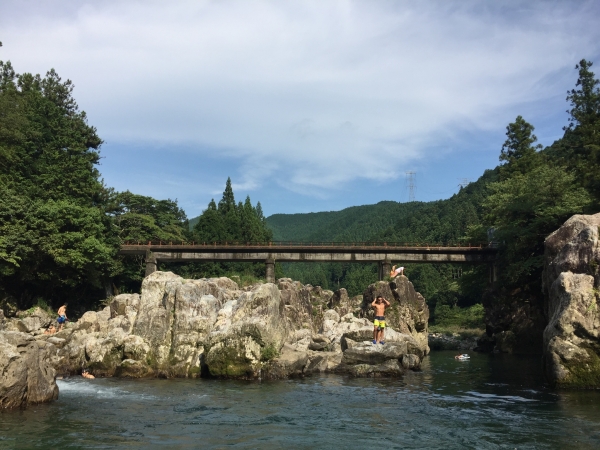Exploring river country: A dive into the mountains and valleys of Gifu

As an island nation, Japan is commonly associated with its beautiful coastlines and stunning ocean views. It’s no wonder, then, that many of its land-locked prefectures are frequently missing from the itineraries of both domestic and international travellers. Gifu Prefecture (岐阜県 Gifu-ken) is no exception to this trend. Located in the Chubu region of Honshu, Japan’s main island, Gifu sits just above Nagoya in a mountainous and expansive swath of land. But what Gifu lacks in beaches and coasts, it more than makes up for with its pristine rivers and gorges. As we head into the hot months of summer, Gifu’s rivers offer a perfect way to escape the heat and the crowds, while exploring a whole new side of Japan.
Riverside recreation

Kawa-asobi at the Itadori River. (Image credit: Josh Grengs)
Hanging out and playing in the river, or kawa-asobi (川遊び) as it’s known in Japanese, is a popular summer pastime throughout Japan. In Gifu, there’s no better place to enjoy this activity than along the Itadori River (板取川 Itadori-gawa). A tributary of the Kiso River (木曽川 Kiso-gawa), the Itadori River is dotted with loads of great spots for swimming, barbecuing, and diving off of boulders into the river’s deep blue waters. To get the most out of a visit here, stay at one of the many campgrounds in the area, and explore the crystal clear waters of the Kiso river system. Suginoko Camping Ground (すぎのこキャンプ場 Suginoko Kyanpu-jō) is one excellent option for visitors looking to barbecue and camp near the river, and it has some great boulder diving spots to boot. Also, when visiting the area, don’t forget to stop by Monet’s Pond (モネの池 Mone no ike). This must-see site looks like a scene right out of a painting by Monet, leaving no speculation as to where it got its name.

A view from Suginoko Camping Ground. (Image credit: Josh Grengs)
Suginoko Camping Ground (すぎのこキャンプ場)
Address: Ichiriboki, Itatori, Seki, Gifu, 501-2901
Nearest bus stop: Suginoko Kyanpujo-mae (すぎのこキャンプ場前)
Tel: +81-582-57-2902

Monet’s Pond. (Image credit: Josh Grengs)
Monet's Pond (モネの池)
Address: Shirotani, Itatori, Seki, Gifu, 501-2901
Nearest bus stop: Ajisaien-mae (白谷あじさい園)
Admission fee: Free
Tel: +81-582-57-2111
A world of waterfalls

Kannon Waterfall. (Image credit: Josh Grengs)
Another great site for exploring Gifu’s brilliant and abundant waters is Tsukechi Gorge (付知峡 Tsukechikyo). Located directly east of the Itadori River, Tsukechi Gorge is a designated Prefectural Natural Park that features an intricate network of waterfalls and waterways. The hillsides surrounding the gorge’s numerous waterfalls have been lined with a system of paths for visitors to walk along and explore the breathtaking natural landscape. Make sure to check out the Kannon and Senjou waterfalls when visiting, and see if you can find any other hidden falls along the way! There are also some great riverside spots near Tsukechi Gorge where you can barbecue and take a refreshing dip in the translucent currents of the Tsukechi River (付知川 Tsukechikawa) and its offshoots before or after your tour of the gorge.
Tsukechi Gorge (付知峡)
Address: 6-39, Tsukechicho, Nakatsugawa, Gifu, 508-0351
Nearest bus stop: Tsukechikyo Fudokoen-guchi (付知峡不動公園口)
Opening hours: Closed for winter
Admission fee: Free
Tel: +81-573-82-4737
Thrills and spills

Sawanobori. (Image credit: photoAC)
For those seeking a bit more adventure during their travels, Gifu is also home to some incredible sites for canyoning, or sawanobori (沢登り). Operating just outside of Gero Hot Springs (下呂温泉 Gero-onsen), Mountain Life Hida offers a range of canyoning courses, from beginner to advanced, in the rivers traversing the Hida (飛騨) region. They also run a “Ninja Forest” obstacle course along with a selection of other exciting outdoor activities. What’s more, they have English-speaking instructors on staff, ensuring no language barrier will stand in the way of you and your adrenaline fix.
Mountain Life Hida (マウンテンライフ飛騨)
Address: 1450, Mazenishimura, Gero, Gifu, 509-2615
Nearest station: Hidahagiwara Station (飛騨萩原駅)
Opening hours: 9:30am–5pm
Tel: +81-90-7671-1609
Grilled perfection

Freshwater eel on rice. (Image credit: Josh Grengs)
No trip to river country would be complete without trying a local grilled dish of unagi (鰻), Japan’s freshwater eel. And thanks to the pristine waters flowing through Gifu’s many rivers, there are few places better than here for savouring this quintessential Japanese delicacy. Ranked as one of the top unagi restaurants in the area, Shigeyoshi (しげ吉) carries a full selection of unagi offerings prepared in the Kansai-style, where the freshwater eel is cut open along its belly, dipped in a rich sauce, and cooked directly over hot coals without any steaming. Be prepared to wait when visiting Shigeyoshi, but trust me, it’s worth it.
Shigeyoshi (しげ吉)
Address: 1-3-29, Sannodori, Seki, Gifu, 501-3252
Nearest station: Seki Station (関駅)
Opening hours: 11am–2pm, 5pm–8pm (closed Tuesdays)
Tel: +81-575-22-9566
Getting there
To get to Itadori River and Monet’s Pond from Nagoya Station, take the Special Rapid Ogaki on the Tokaido Line to Gifu Station and transfer to bus N83 at Platform 12 bound for Horado Kiwi Plaza. Next, walk one minute to Horado Ichiba and take the Iradori Fureai Bus to Ajisai-mae bus stop. It’s about a 2-minute walk to Monet’s Pond from there, and you can get off the Iradori Fureai Bus along the way to explore the Itadori River.
For Tsukechi Gorge, take the Shinano 1 Limited Express Nagano from Nagoya Station to Nakatsugawa Station. Walk to Nakatsugawa Eki-mae and take the Kashimo Line to Kaiseido and transfer to the Tsukechi Line at Kaiseido-iin. Get off at Tsukechikyo Fudokoen-guchi and walk five minutes until you reach the gorge.
As Gifu’s public transportation is relatively less developed than the transportation systems found in Japan’s major metropolises, I suggest taking the train to JR Gifu Station and renting a car from there to maximize both time and money. For more details on International Driving Permits, click here.
Header image credit: Josh Grengs





